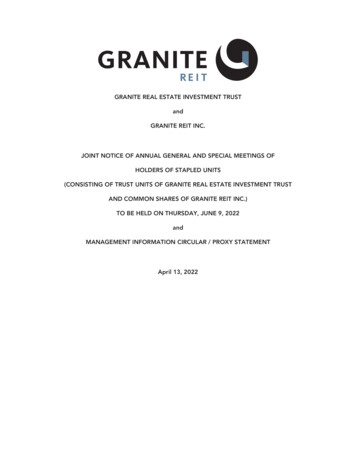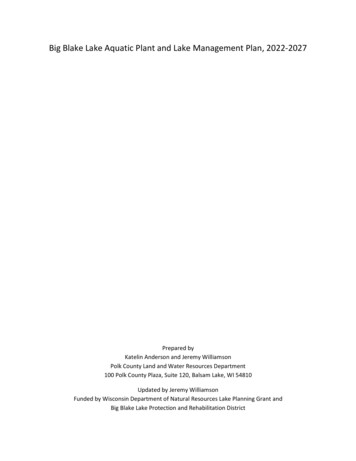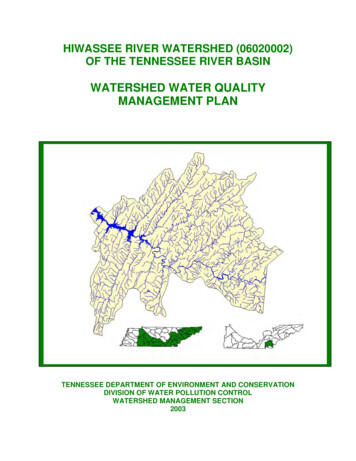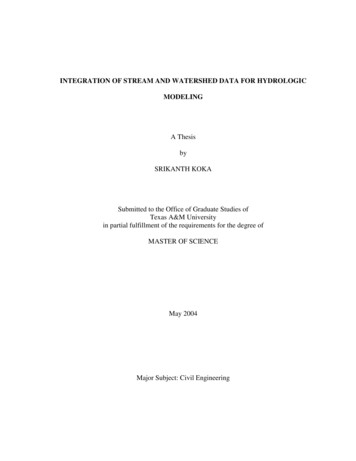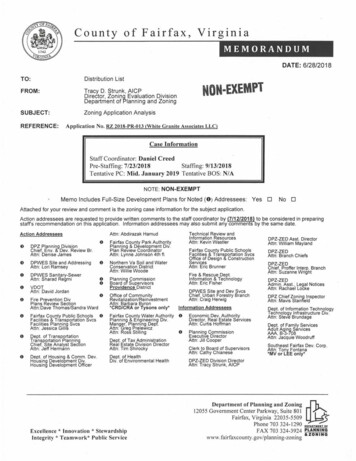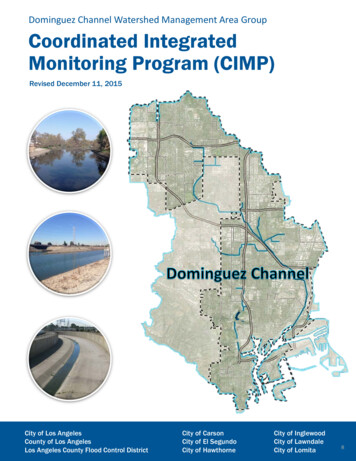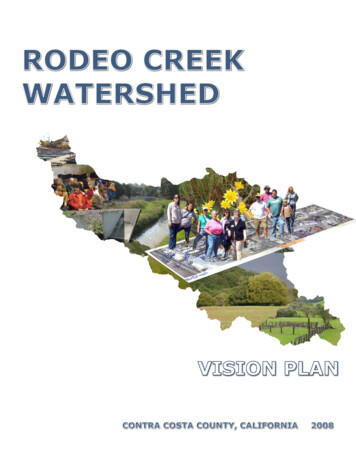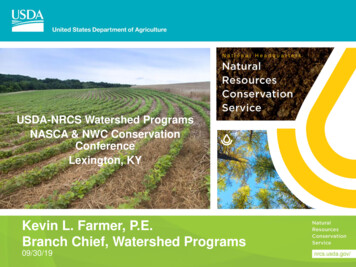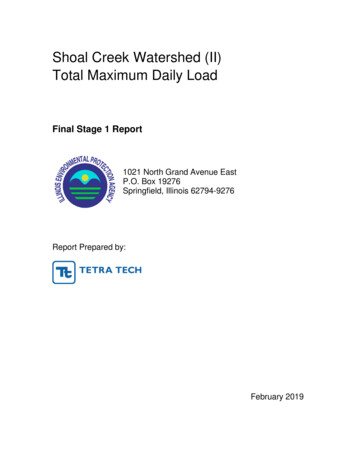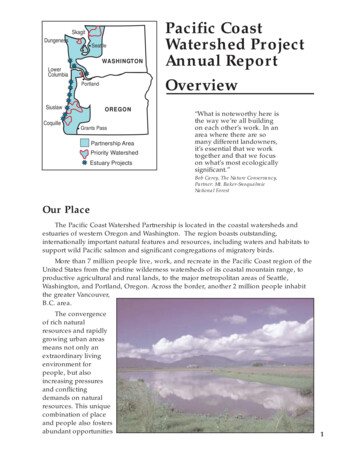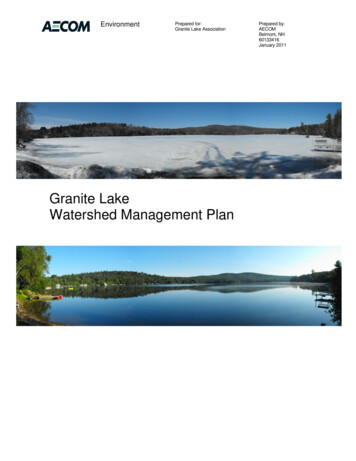
Transcription
EnvironmentPrepared for:Granite Lake AssociationGranite LakeWatershed Management PlanPrepared by:AECOMBelmont, NH60133416January 2011
EnvironmentPrepared for:Granite Lake AssociationGranite LakeWatershed Management PlanPrepared By:Sarah MacDougall and Al PrattReviewed By:Don KretchmerPrepared by:AECOMBelmont, NH60133416January 2011
AECOMEnvironmentiContents1.0 Introduction. 1-12.0 Phosphorus Target . 2-12.1Numeric Water Quality Target . 2-13.0 ENSR-LRM Model of Current Conditions . 3-13.1Hydrologic Inputs and Water Loading . 3-43.2Nutrient Inputs . 3-43.3Phosphorus Loading Assessment Summary. 3-83.4Phosphorus Loading Assessment Limitations . 3-83.5Lake Response to Current Phosphorus Loads. 3-93.7Future Development . 3-113.8Critical Conditions . 3-123.9Seasonal Variation . 3-123.10Reduction Needed . 3-123.11Loading Model Development Summary. 3-134.0 Evaluation of Alternative Loading Scenarios . 4-14.1Natural Environmental Background Phosphorus Loading . 4-24.2Build Out Analysis . 4-34.3Septic System Load Removal . 4-34.4Maximum Route 9 Construction . 4-34.5Reduction of Loads to Meet In-lake Short-Term TP Goal of 4.75 g/L Summer In-LakeConcentration . 4-45.0 Additional Watershed Concerns . 5-15.1Road Salt. 5-15.2Water Level Management . 5-35.3Near Shore Septic Survey . 5-45.4Near-shore Groundwater Sampling Training . 5-46.0 Implementation Plan . 6-17.0 Options for Managing Phosphorus Loading to Granite Lake . 7-1
AECOMEnvironmentii7.1Land Development . 7-17.1.1Existing Protection for Land Development . 7-17.1.2Considerations for Management of Land Development . 7-37.2Roads and Stormwater Management . 7-47.2.1Road Maintenance . 7-47.2.2Stormwater Management Practices . 7-57.3In-Lake and Shoreland Management. 7-87.4Septic System Inventory, Maintenance, and Upgrades . 7-87.5Timber Harvesting. 7-107.6Agriculture . 7-107.7Granite Lake - Site-Specific, Non-Point Source Management Measures . 7-107.7.1North Shore Road Catch Basins, Culverts, and Swales . 7-117.7.2West Shore Road / North Shore Road Intersection Culverts and Swales. 7-127.7.3West Shore Road Culverts and Swales . 7-127.7.4Nelson Fire Station Parking Lot . 7-147.7.5Granite Lake Boat Ramp . 7-157.7.6Granite Lake Road Catch Basins and Direct Drainage . 7-167.7.7Route 9, Nye Road, and NH DOT Storage Area . 7-168.0 Phosphorus Management Summary and Implementation Schedule . 8-18.1Septic System Survey and Shallow Groundwater Sampling . 8-18.2Road Maintenance and Storm Water Drainage Improvements . 8-39.0 Public Outreach and Education . 9-110.0 Monitoring Plan . 10-111.0 Potential Sources of Funding . 11-112.0 References . 12-1
AECOMEnvironmentiiiList of AppendicesAppendix A Granite Water Quality Target Discussion Minutes December 3, 2009Appendix B ENSR LRM DocumentationAppendix C NHDES Shoreland Fact SheetsAppendix D NHDES Watershed Management of Fact SheetsAppendix E NHDES Septic System Fact SheetsAppendix F NHDES Chapman Stormwater ReportAppendix G ENSR LRM Coefficients and DataList of Tables1Table 1-1: Characteristics of Granite Lake, Nelson and Stoddard, NH . 1-1Table 1-2: Lake Summer Water Quality Summary Table 2003-2009 . 1-4Table 3-1: Granite Lake Water Budget . 3-4Table 3-2: Granite Lake Phosphorous Loading Summary . 3-8Table 3-3: Predicted In-Lake Total Phosphorous Concentration using Empirical Models . 3-10Table 3-4: Predicted In-Lake Chlorophyll a and Secchi Disk Transparency Predictions based on anAnnual Average In-Lake Phosphorous Concentration of 12 g/L . 3-11Table 3-5: Granite Lake Total Phosphorous Load at Short Term Goal of 4.75 g/L . 3-13Table 4-1: Comparison of Phosphorous Loading Scenarios for Granite Lake . 4-1Table 4-2: Lake Water Quality Response to Different Loading Scenarios for Granite Lake . 4-2Table 5-1: Salt Load by Basin to Granite Lake (note that other basins had no salt load) . 5-3Table 6-1: Best Management Practices Selection Matrix . 6-3Table 8-1: Recommended Measures to Manage Phosphorous Loading to Granite Lake – LoadReduction Estimates for Road Drainage Improvements . 8-4Table 8-2: Recommended Measures to Manage Phosphorus Loading to Granite Lake – CostEstimates for Road Drainage Improvements . 8-6Table 8-3: Recommended Measures to Reduce Phosphorus Loading to Granite Lake - Septic andLand Management Practices . 8-8Table 8-4: Implementation Schedule . 8-9
AECOMEnvironmentivList of FiguresFigure 1-1: Granite Lake Location and Bathymetry . 1-2Figure 2-1: Granite Lake Drainage Basins . 2-1Figure 3-1: Granite Lake Watershed Land Use . 3-3Figure 5-1: Specific Conductance in Granite Lake (1976-2009) . 5-2Figure 7-1: Sites for Best Management Practice Implementation . 7-11Figure 7-2: Sites for BMP Implementation Near Route 9 Bridge. 7-17
AECOMEnvironmentES-1Executive SummaryA watershed management plan was prepared for Granite Lake, New Hampshire. Granite Lake is ahigh quality lake but has experienced a cyanobacteria bloom in recent years. This effort included theconstruction of a nutrient budget and setting a target value for phosphorus that would not cause algalblooms and preserve the lake in the pristine state it has been in historically. Limiting phosphorusconcentrations and associated algal growth should be sufficient to maintain water quality throughoutthe lake. The phosphorus loads are allocated among sources of phosphorus such that in-lakephosphorus concentrations meet the target and Granite Lake supports its designated uses. Theanalysis suggests that the current loads of phosphorus to Granite Lake should be reduced by 6.5%overall in order to maintain the target in-lake phosphorus value of 5 g/L and the short-term goal of4.75 g/L and allow for some future increases. The plan puts primary emphasis on reducingwatershed phosphorus sources over other sources due to the relative load contribution from thewatershed and practical implementation considerations. It is expected that these reductions would bephased in over a period of several years. Successful implementation of this watershed managementplan will be based on maintenance of in lake total phosphorus concentrations at or below thephosphorus target. Specific targeted measures to control phosphorus inputs to the lake are presentedand discussed. Guidance for obtaining additional Clean Water Act (Section 319) funding for nonpointsource control is presented in Section 11.0. Suggestions for enhancement of the current monitoringprogram to monitor progress and effectiveness of control measures are provided.
AECOM1.0Environment1-1IntroductionGranite Lake is a 228 acre lake with a watershed of about 2,432 acres entirely within the towns ofNelson and Stoddard (NHDES 2009). Characteristics of Granite Lake are presented in Table 1-1.The watershed to lake area ratio is 11:1. Lakes with watershed ratios greater than 10:1 canexperience low water clarity, high phosphorus and obnoxious algal blooms when the watershed ishighly developed or has high export of nutrients. Furthermore, the amount of impervious cover (i.e.,development) within a watershed is correlated with water quality. Poor water quality and significantchanges in hydrology are typically experienced in watersheds where impervious cover is at or greaterthan 10% of the total area (CWP 2003). In areas where impervious cover is greater than 25% (CWP2003) waters are typically of poor quality and may not support such uses as swimming, and drinking.Although the Granite Lake watershed is below the 10% threshold, localized, short-term or periodicwater quality problems may be still be observed. The recent cyanobacteria bloom in Granite Lake islikely a reaction to a short term loading episode.1Table 1-1: Characteristics of Granite Lake, Nelson and Stoddard, NHParameterValueLake Area (acres)3Lake Volume (m )Watershed Area (acres)Watershed/Lake AreaMean Depth (m)Max Depth (m)-1Flushing Rate (yr )Epilimnetic TP (ug/L mean, range)Hypolimnetic TP (ug/L mean, range)Epilimnion TN:TP Ratio22811,525,0002,432119.828.90.724.9, 2.5-12.05.3, 2.5-10.0261Water quality statistics are calculated from 2003-2009 dataRecent water quality data from the New Hampshire Volunteer Lake Assessment Program websitewere reviewed in the 2008 VLAP report (NHDES 2009). Total phosphorus (TP) and chlorophyll a (ameasure of the amount of algae) concentrations have shown considerable variability over years but areview of the data suggests that mean concentrations are low and have not changed significantly overtime. A blue-green alga, anabaena, was found to be the dominant species in July 2006. This specieswas also dominant in 2002. Blue-green algae can release toxins that can be potentially harmful toanimals and humans. In contrast to recent increases in TP and chlorophyll a is water clarity, whichappears to be increasing with time. This may be an artifact of sample methodology, however, asexplained in the Volunteer Lake Assessment Reports. There is considerable variation in water clarityover the years as well. The lake is quite deep relative to its size, with a mean and maximum depth of9.8 and 28.9 meters (NHDES 2007a, Figure 1-1). Deep lakes in the northern temperate regiontypically undergo thermal stratification . During stratification, oxygen in bottom waters can getdepleted by organic matter decomposition processes. In the absence of oxygen, phosphorus can bereleased from iron in the bottom sediments and be circulated into the water column becomingavailable for algal uptake. Figure 1-2 shows temperature and dissolved oxygen concentrations from
AECOMEnvironment1-2profiles conducted in 2004, 2005 and 2006. Oxygen concentrations were high at all depths sampledwith the exception of locations very close to the bottom and mid water column depths during August of2004. Oxygen concentrations in the deep zones of lakes are typically at a minimum just before fallturnover which typically occurs in late September or early October. The latest dissolved oxygen dataavailable are from August so it is possible that concentrations in Granite Lake get lower prior toturnover. The mid-depth dissolved oxygen minima observed in August 2004 may be due to anaccumulation of dying algal cells in the metalimnion and upper hypolimnion.Figure 1-1: Granite Lake Location and BathymetryGranite Lake supports a cold water fishery as well as a number of warm water fish species.According to New Hampshire Fish and Game (2010) the lake supports rainbow trout (stocked), laketrout, smallmouth bass, rock bass, chain pickerel and hornpout.
AECOMEnvironment1-3Cyanobacteria (anabaena) were reported in Granite Lake in 2007 (NHDES 2007a). Cyanobacteriaand other algal species typically increase in numbers in response to nutrient enrichment.Phosphorus is the primary limiting nutrient in northern temperate lakes, hence algal growth is likelydirectly related to phosphorus concentrations. Nitrogen can also play a role in determining the type ofalgae present and the amount of algal growth in a waterbody since some cyanobacteria (blue-greenalgae) can fix nitrogen from the atmosphere. An examination of water quality data from 2003 to 2009shows a total nitrogen to total phosphorus ratio of 26. This ratio suggests that algal growth in GraniteLake is limited by phosphorus, making control of phosphorus the primary focus of watershedmanagement efforts. Additionally, phosphorus is typically more easily controlled than nitrogen. Awatershed management plan for total phosphorus (TP) as a surrogate for chl a and cyanobacteria hasbeen prepared for Granite Lake and the results are presented in this report. Chloride (from road salt)has also been identified as a potential issue in the lake and watershed. A discussion of chlorideloading is also presented.The New Hampshire Department of Environmental Services (NH DES) conducted water qualitymonitoring of Granite Lake in 1985-86, 1996-97, and 2006-07 for Lake Trophic Studies (NHDES1986, NHDES 1997, NHDES 2007a). Granite Lake has participated in the Volunteer LakeAssessment Program (VLAP) since 1989 (NH DES 2009). Granite Lake also participates in the LakeHost program (NHDES 2009) to educate boaters and examine boats and trailers for exotic plantsentering or leaving lakes.The mean, median and range of selected water quality parameters from each sampling location fromthe most recent data available (2003-2009) are summarized in Table 1-2. Secchi disk transparencies(SDT), a measure of water clarity, are high, ranging from 6.1 to 14.0 m with a mean of 9.8 m.Chlorophyll a (chl a) concentrations, a measure of algal productivity, are low over this time periodranging from 0.5 to 2.7 g/L. TP concentrations (the primary nutrient for algal growth) in theepilimnion range from 2.5 to 12 g/L with a mean of 4.9 g/L. Hypolimnetic TP concentrations aresimilar to epilimnetic concentrations ranging from 2.5 to 10 g/L with a mean of 5.3 g/L. Similarsurface and bottom concentrations during the summer stratification period suggest that there iscurrently little to no sediment release of TP. NHDES (2009) concluded through a visual inspection ofwater quality data collected since 1989 that summer composite chl a concentrations and TPconcentrations have not changed and that Secchi transparencies have increased. All of thesemeasures showed that Granite Lake water quality was much better than the typical NH lake and betterthan most similar high quality lakes.
AECOMEnvironment1-4Table 1-2: Lake Summer Water Quality Summary Table 2003-2009StatisticTPEpiTP 50Median5.05.05.412.59.91.40.1250.1250.0500.050n number of samples; Epi epilimnion; Meta metalimnion; Hypo hypolimnion; SDT Secchi DiskTransparency, Chl a Chlorophyll a, DO Dissolved Oxygen* Uncorrected for phaeophytin** DO values are from each discrete observation in the data set regardless of depth*** Data suspected to be invalid, not used in calculations.Granite Lake has numerous tributaries and direct stormwater inputs (Figure 1-2). A summary of thedata from the tributaries is presented in Appendix G, Table G-1. Water quality entering the lake fromthese points could be improved. Conductivity, an indirect measure of charged ions in water, in thelake and within tributaries has increased over time (NHDES 2009). A major source of these ions inmany New Hampshire lakes is road salt. In addition, tributary TP and turbidity were elevated at theprimary inlet. Specific stormwater improvements have been suggested by the New HampshireDepartment of Environmental Services (NHDES) in Granite Lake Stoddard/Nelson StormwaterDrainage for North Shore and West Shore Roads (NHDES 2007c, Appendix F). We suggest severaladditional best management practices (both structural and non-structural to lower loads of phosphorusto Granite Lake.These data, together with suggested management recommendations, provide a basis for thedevelopment of a Watershed Management Plan for Granite Lake. Outreach and education will be animportant aspect of this project. A Site Specific Project Plan (SSPP) detailing the steps to beundertaken in development of the plan was presented to NHDES in the fall of 2009 and approved.The purpose of the Granite Lake watershed plan is to establish TP loading targets, a plan to meetthose targets and a means for measuring progress. Once completed and implemented, the planshould protect the pristine nature of Granite Lake. Water quality that is consistent with state standardsis, a priori, expected to protect designated uses. This plan recognizes the unique nature of GraniteLake as a high quality water and sets targets and goals well beyond what would be required to protectdesignated uses. AECOM prepared this watershed plan according to the United StatesEnvironmental Protection Agency's (US EPA) guidance (US EPA, 2008). The main objectives of thiswatershed plan include the following 9 elements from the EPA guidance:1. Identification of causes of impairment and pollutant sources or groups of similar sources thatneed to be controlled to achieve needed load reductions, and any other goals identified in thewatershed plan. Sources that need to be controlled should be identified at the significant
AECOMEnvironment1-5subcategory level along with estimates of the extent to which they are present in thewatershed (e.g., X number of dairy cattle feedlots needing upgrading, including a roughestimate of the number of cattle per facility; Y acres of row crops needing improved nutrientmanagement or sediment control; or Z linear miles of eroded streambank needingremediation).2. An estimate of the load reductions expected from management measures.3. A description of the nonpoint source management measures that will need to be implementedto achieve load reductions in paragraph 2, and a description of the critical areas in whichthose measures will be needed to implement this plan.4. Estimate of the amounts of technical and financial assistance needed, associated costs,and/or the sources and authorities that will be relied upon to implement this plan.5. An information and education component used to enhance public understanding of the projectand encourage their early and continued participation in selecting, designing, andimplementing the nonpoint source management measures that will be implemented.6. Schedule for implementing the nonpoint source management measures identified in this planthat is reasonably expeditious.7. A description of interim measurable milestones for determining whether nonpoint sourcemanagement measures or other control actions are being implemented.8. A set of criteria that can be used to determine whether loading reductions are being achievedover time and substantial progress is being made toward attaining water quality standards.9. A monitoring component to evaluate the effectiveness of the implementation efforts over time,measured against the criteria established under item 8 immediately above.This watershed management plan is expected to fulfill the nine requirements for a watershedmanagement plan required to qualify a project for Section 319 restoration funding.
AECOMEnvironment2.0Phosphorus Target2.1Numeric Water Quality Target2-1To develop a watershed management plan, it is necessary to derive a numeric TP target values (e.g.,in-lake concentration) for determining acceptable nutrient loads. The suggested TP values aredescribed in the following paragraphs.Figure 2-1: Granite Lake Drainage BasinsDetermining the nutrient load that a lake can assimilate without degrading or exceeding water qualitystandards is challenging and complex. First, many lakes receive a high proportion of their nutrientloading from non-point sources, which are highly variable and are difficult to quantify. Secondly, lakesdemonstrate nutrient loading on a seasonal scale, not a daily basis. Loading during the winter monthsmay have little effect on summer algal densities. Finally, variability in loading may be very high inresponse to weather patterns, and the forms in which nutrients enter lakes may cause increasedvariability in response. Therefore, it is usually considered most appropriate to quantify a lake nutrientbudget as an annual load and evaluate the results of that annual load on mid-summer conditions thatare most critical to supporting recreational uses. Accordingly, the nutrient loading capacity of lakes is
AECOMEnvironment2-2typically determined through water quality modeling, which is usually expressed on an annual basis.Thus, while a single value may be chosen as the target load for each nutrient, it represents a range ofloads with a probability distribution for associated water quality problems (such as algal blooms).Uncertainty is likely to be very high, and the resulting target load should be viewed as a nutrientloading goal that helps set the direction and magnitude of management, not as a rigid standard thatmust be achieved to protect against eutrophication. While data from individual sampling dates andseasons are important to understanding the nutrient loading dynamics of Granite Lake, the annualmean load should be given primacy when developing and evaluating the effectiveness of nutrientloading reduction strategies.Numerical water quality criteria for TP in oligotrophic lakes were recently developed by the State ofNew Hampshire. For Granite Lake, an oligotrophic lake, the criteria is set at 8 μg/L. This criteria is60% higher than the current summer epilimnetic concentration of TP (5.0 μg/L) and 27% higher thanthe current annual average TP concentration (6.3 μg/L). Best professional judgment of AECOM, NHDES, and the Granite Lake Association was employed to select a quantitative target in-lake TPconcentration that will protect water quality. Review of existing data and modeling of currentconditions suggested that the current phosphorus concentrations in the lake would result inacceptable water quality going forward. This point is bolstered by the fact that water quality asmeasured by chl a and TP has not changed appreciably in recent years. However, it wasacknowledged that short-term phenomenon had the potential to cause periodic water quality problemslike the bloom experienced in 2006 and the anecdotal evidence that nearshore water quality may bedeclining. It was further recognized that there would be future development in the watershed.A meeting was convened on December 3, 2009 with NHDES, AECOM and the Town of Nelson topresent target options and come to a consensus on an acceptable target for Granite Lake. Using theconceptual assimilative capacity approach and a criteria of 8 ug/L as the cutoff point betweenoligotropic and mesotrophic lakes, the target for Granite Lake could be set at 0.5 ug/L higher thanexisting conditions allowing for a 10% reserve and using 20% of the remaining assimilative capacity.It was agreed that this target was too high for Granite Lake given that periodic water quality problemshad been experienced at current levels of phosphorus despite the fact that the annual average TP andchlor a concentration has been steady in recent years. Meeting attendees reached consensus thatthe water quality target should be set at current conditions mean summer in-lake total phosphorusconcentrations of approximately 5.0 g/L, but that a short term mean summer goal of 4.75 g/Lshould be established to reduce the watershed phosphorus load as much as practical with BestManagement Practices (BMPs) recognizing that future development was likely in the watershed. Theshort term mean summer epilimnetic goal (4.75 g/L) corresponds to a spring overturn value of 5.9g/L. This is compared to a current spring overturn value of 6.3 g/L. This target and short term goalwere then presented to the Town of Stoddard who agreed with the recommendation. Load reductionthrough BMP’s is discussed further in Section 9 of the report.The numeric (in-lake) water quality target for TP for Granite Lake is 5.0 g/L for a summer epilimneticmean concentration which equates to a spring overturn TP concentration of 6.3 g/l because meanannual TP concentrations are usually higher than summer epilimnetic concentrations (Nurnberg 1996,1998. The target number is supported by evaluation of the Trophic State Indices (TSI) developed byCarlson (1977) and a probabilistic assessment of the likelihood of blooms (Walker 1984, 2000)discussed below. The “weight of evidence” suggests that 5 g/L is an appropriate target that will allowGranite Lake to remain in its current pristine state. Possible reductions to move Granite Lake belowthis target to a short term goal in lake summer mean concentration of 4.75 g/L to allow for futureincreases in TP are discussed in Section 7 below. This equates to a spring overturn concentration of5.9 g/L The target concentration corresponds to non-bloom conditions, as reflected in suitablemeasures of both SDT and chl a.
AECOM3.0Environment3-1ENSR-LRM Model of Current ConditionsCurrent TP loading was assessed using the ENSR-LRM methodology, which is a land use exportcoefficient model developed by AECOM for use in New England and modified for New Hampshirelakes by incorporating New Hampshire land use TP export coefficients when available and addingseptic system loading into the model (CT DEP and ENSR, 2004). Documentation for ENSR-LLRM isprovided in Appendix B. Both STEPL and AVGWLF were also run for the Granite Lake watershed.While all three approaches gave similar results, the scale of AVGWLF made it inappropriate for furtherconsideration. It is designed for very lar
A watershed management plan was prepared for Granite Lake, New Hampshire. Granite Lake is a high quality lake but has experienced a cyanobacteria bloom in recent years. This effort included the construction of a nutrient budget and setting a target value for phosphorus that would not cause algal
